2011 INFINITI QX56 ECU
[x] Cancel search: ECUPage 1582 of 5598
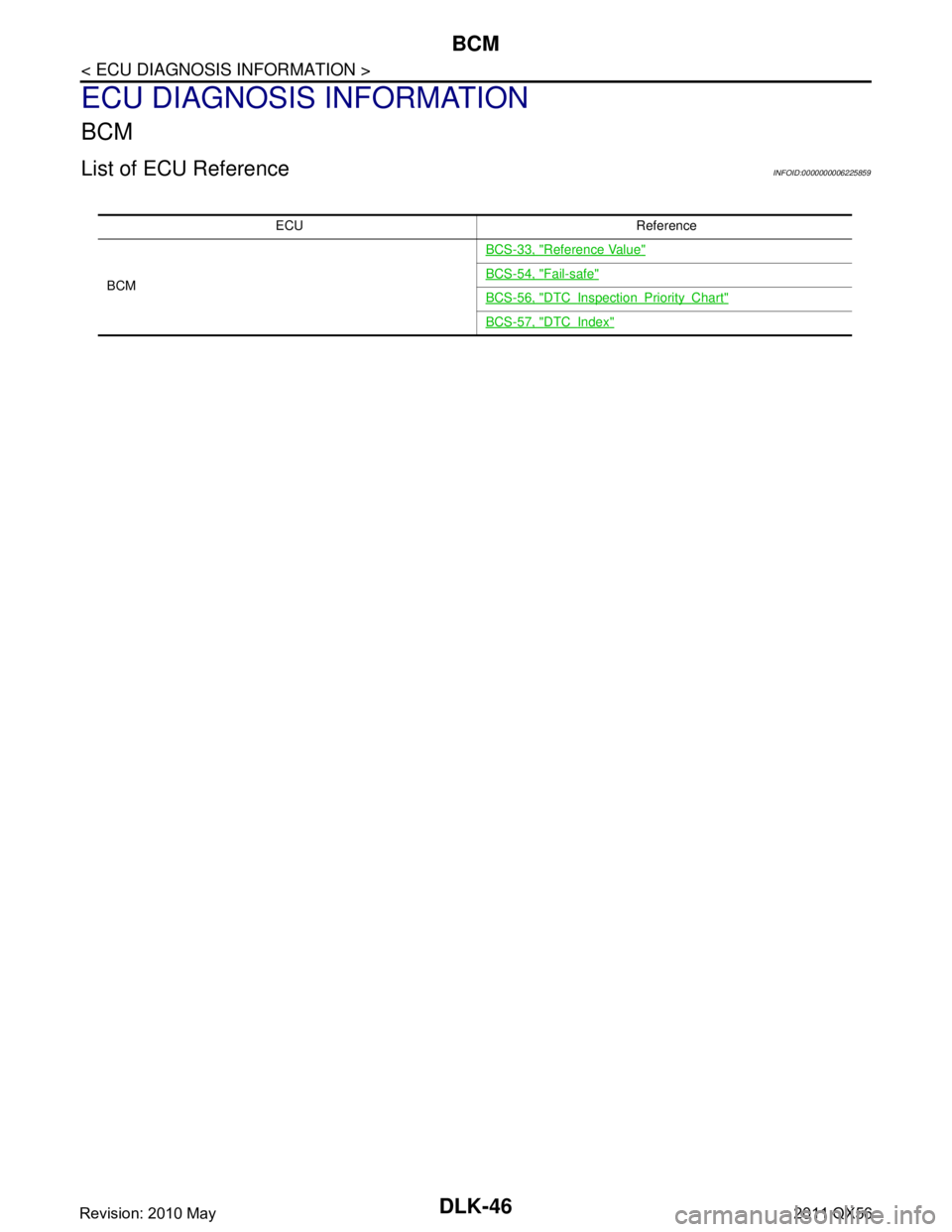
DLK-46
< ECU DIAGNOSIS INFORMATION >
BCM
ECU DIAGNOSIS INFORMATION
BCM
List of ECU ReferenceINFOID:0000000006225859
ECU Reference
BCM BCS-33, "
Reference Value"
BCS-54, "Fail-safe"
BCS-56, "DTCInspectionPriorityChart"
BCS-57, "DTCIndex"
Revision: 2010 May2011 QX56
Page 1583 of 5598
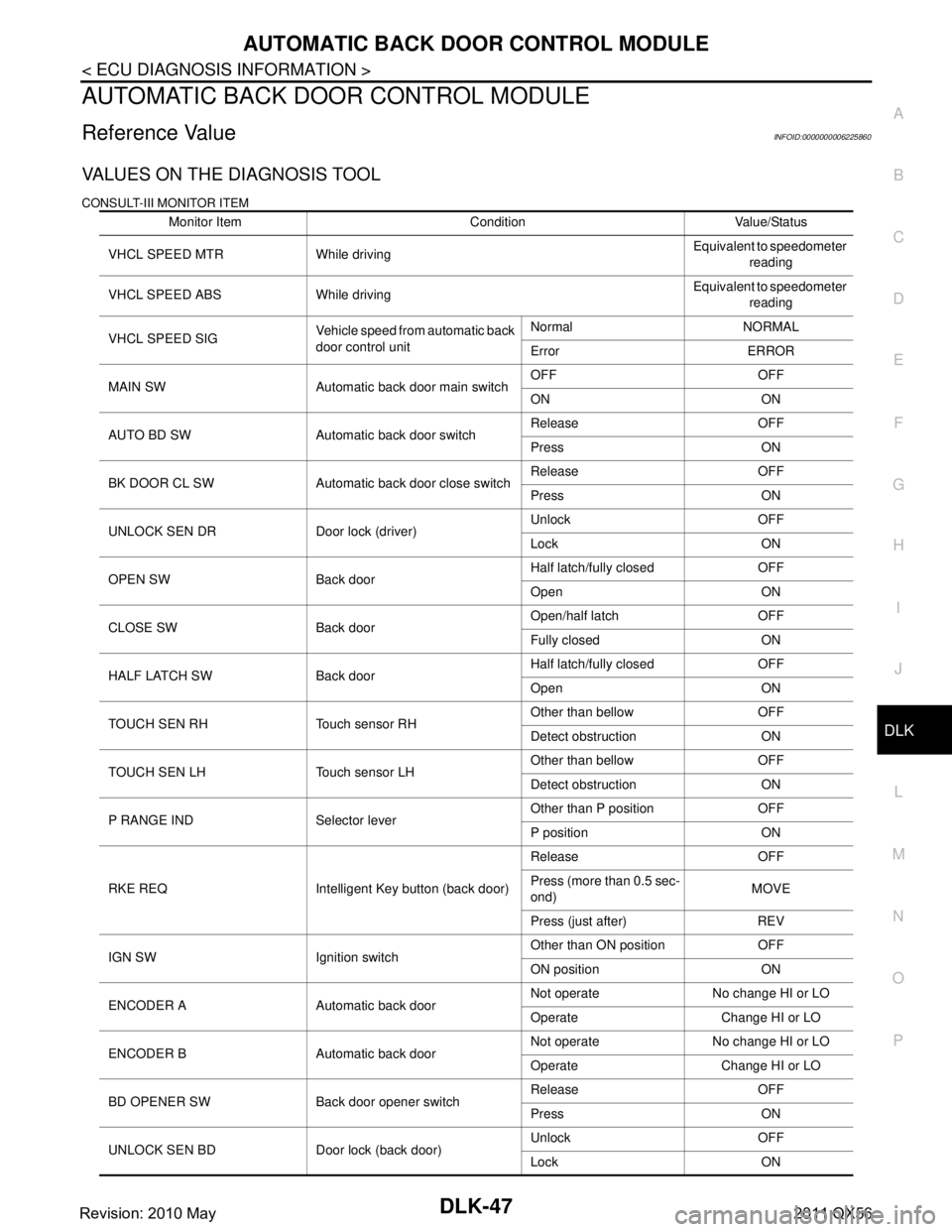
AUTOMATIC BACK DOOR CONTROL MODULEDLK-47
< ECU DIAGNOSIS INFORMATION >
C
DE
F
G H
I
J
L
M A
B
DLK
N
O P
AUTOMATIC BACK DOOR CONTROL MODULE
Reference ValueINFOID:0000000006225860
VALUES ON THE DIAGNOSIS TOOL
CONSULT-III MONITOR ITEM
Monitor Item Condition Value/Status
VHCL SPEED MTR While driving Equivalent to speedometer
reading
VHCL SPEED ABS While driving Equivalent to speedometer
reading
VHCL SPEED SIG Vehicle speed from automatic back
door control unit Normal NORMAL
Error ERROR
MAIN SW Automatic back door main switch OFF OFF
ON ON
AUTO BD SW Automatic back door switch Release OFF
Press ON
BK DOOR CL SW Automatic back door close switch Release OFF
Press ON
UNLOCK SEN DR Door lock (driver) Unlock OFF
Lock ON
OPEN SW Back door Half latch/fully closed OFF
Open ON
CLOSE SW Back door Open/half latch OFF
Fully closed ON
HALF LATCH SW Back door Half latch/fully closed OFF
Open ON
TOUCH SEN RH Touch sensor RH Other than bellow OFF
Detect obstruction ON
TOUCH SEN LH Touch sensor LH Other than bellow OFF
Detect obstruction ON
P RANGE IND Selector lever Other than P position OFF
P position ON
RKE REQ Intelligent Key button (back door) Release OFF
Press (more than 0.5 sec-
ond)
MOVE
Press (just after) REV
IGN SW Ignition switch Other than ON position OFF
ON position ON
ENCODER A Automatic back door Not operate No change HI or LO
Operate Change HI or LO
ENCODER B Automatic back door Not operate No change HI or LO
Operate Change HI or LO
BD OPENER SW Back door opener switch Release OFF
Press ON
UNLOCK SEN BD Door lock (back door) Unlock OFF
Lock ON
Revision: 2010 May2011 QX56
Page 1584 of 5598
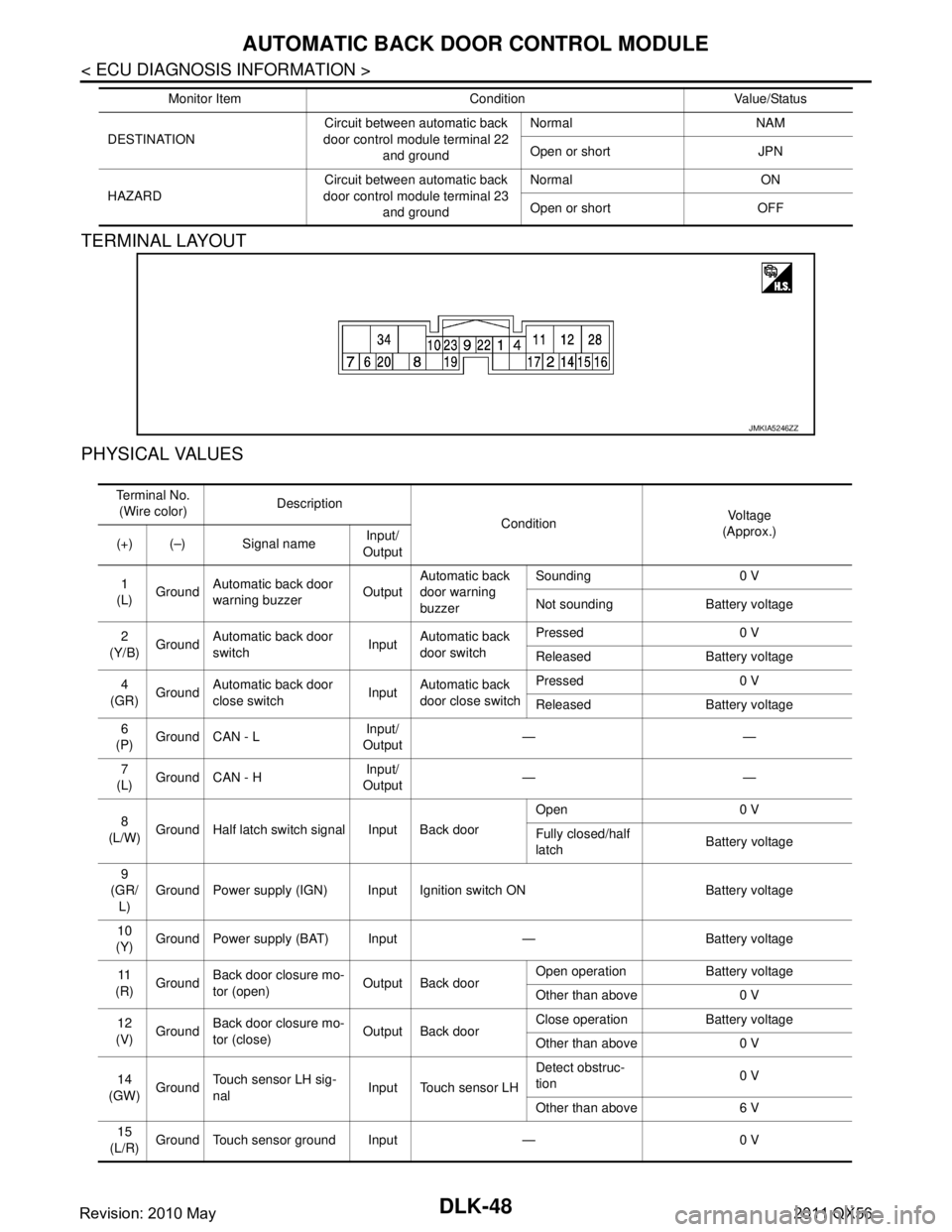
DLK-48
< ECU DIAGNOSIS INFORMATION >
AUTOMATIC BACK DOOR CONTROL MODULE
TERMINAL LAYOUT
PHYSICAL VALUES
DESTINATIONCircuit between automatic back
door control module terminal 22
and ground Normal NAM
Open or short JPN
HAZARD Circuit between automatic back
door control module terminal 23 and ground Normal ON
Open or short OFF
Monitor Item Condition Value/Status
JMKIA5246ZZ
Te r m i n a l N o .
(Wire color) Description
Condition Vo l ta g e
(Approx.)
(+) (–) Signal name Input/
Output
1
(L) Ground
Automatic back door
warning buzzer OutputAutomatic back
door warning
buzzer Sounding 0 V
Not sounding Battery voltage
2
(Y/B) Ground Automatic back door
switch InputAutomatic back
door switch Pressed 0 V
Released Battery voltage
4
(GR) Ground Automatic back door
close switch InputAutomatic back
door close switch Pressed 0 V
Released Battery voltage
6
(P) Ground CAN - L
Input/
Output ——
7
(L) Ground CAN - H Input/
Output ——
8
(L/W) Ground Half latch switch signal Input Back door Open 0 V
Fully closed/half
latch
Battery voltage
9
(GR/ L) Ground Power supply (IGN) Input Ignition switch ON Battery voltage
10
(Y) Ground Power supply (BAT) Input — Battery voltage
11
(R) Ground
Back door closure mo-
tor (open) Output Back door Open operation Battery voltage
Other than above 0 V
12
(V) Ground
Back door closure mo-
tor (close) Output Back door Close operation Battery voltage
Other than above 0 V
14
(GW) Ground Touch sensor LH sig-
nal
Input Touch sensor LH Detect obstruc-
tion
0 V
Other than above 6 V
15
(L/R) Ground Touch sensor ground Input — 0 V
Revision: 2010 May2011 QX56
Page 1585 of 5598
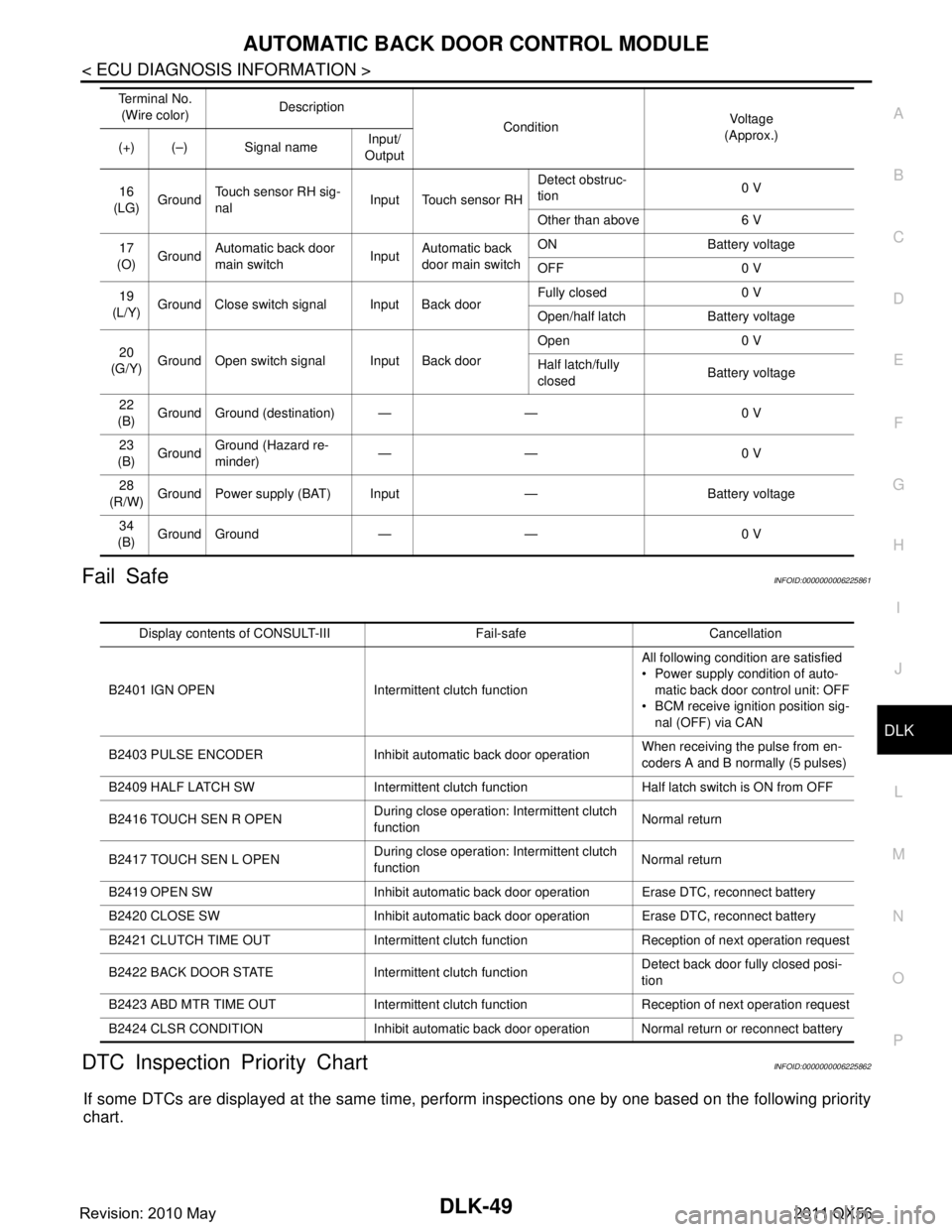
AUTOMATIC BACK DOOR CONTROL MODULEDLK-49
< ECU DIAGNOSIS INFORMATION >
C
DE
F
G H
I
J
L
M A
B
DLK
N
O P
Fail SafeINFOID:0000000006225861
DTC Inspection Priority ChartINFOID:0000000006225862
If some DTCs are displayed at the same time, per form inspections one by one based on the following priority
chart.
16
(LG) Ground
Touch sensor RH sig-
nal Input Touch sensor RH Detect obstruc-
tion
0 V
Other than above 6 V
17
(O) Ground Automatic back door
main switch
InputAutomatic back
door main switch ON Battery voltage
OFF 0 V
19
(L/Y) Ground Close switch signal Input Back door Fully closed 0 V
Open/half latch Battery voltage
20
(G/Y) Ground Open switch signal Input Back door Open 0 V
Half latch/fully
closed
Battery voltage
22
(B) Ground Ground (destination) — — 0 V
23
(B) Ground
Ground (Hazard re-
minder) —— 0 V
28
(R/W) Ground Power supply (BAT) Input — Battery voltage
34
(B) Ground Ground — — 0 V
Te r m i n a l N o .
(Wire color) Description
Condition Vo l ta g e
(Approx.)
(+) (–) Signal name Input/
Output
Display contents of CONSUL T-III Fail-safe Cancellation
B2401 IGN OPEN Intermittent clutch function All following condition are satisfied
Power supply condition of auto-
matic back door control unit: OFF
BCM receive ignition position sig- nal (OFF) via CAN
B2403 PULSE ENCODER Inhibit automatic back door operation When receiving the pulse from en-
coders A and B normally (5 pulses)
B2409 HALF LATCH SW Intermittent clutch function Half latch switch is ON from OFF
B2416 TOUCH SEN R OPEN During close operation: Intermittent clutch
function
Normal return
B2417 TOUCH SEN L OPEN During close operation: Intermittent clutch
function Normal return
B2419 OPEN SW Inhibit automatic back door operation Erase DTC, reconnect battery
B2420 CLOSE SW Inhibit automatic back door operation Erase DTC, reconnect battery
B2421 CLUTCH TIME OUT Intermittent clutch function Reception of next operation request
B2422 BACK DOOR STATE Intermittent clutch function Detect back door fully closed posi-
tion
B2423 ABD MTR TIME OUT Intermittent clutch function Reception of next operation request
B2424 CLSR CONDITION Inhibit automatic back door operation Normal return or reconnect battery
Revision: 2010 May2011 QX56
Page 1586 of 5598
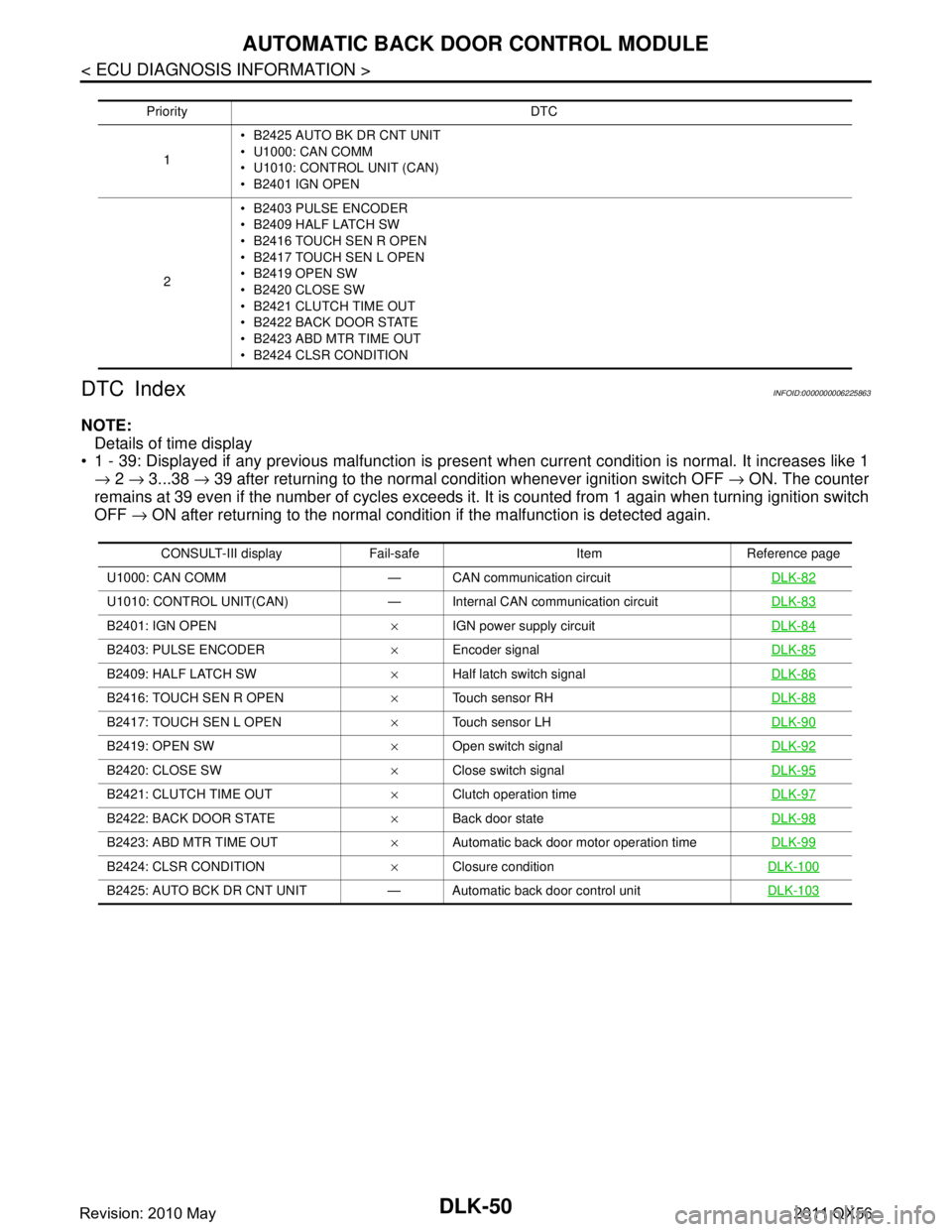
DLK-50
< ECU DIAGNOSIS INFORMATION >
AUTOMATIC BACK DOOR CONTROL MODULE
DTC Index
INFOID:0000000006225863
NOTE: Details of time display
1 - 39: Displayed if any previous malfunction is present when current condition is normal. It increases like 1
→ 2 → 3...38 → 39 after returning to the normal condition whenever ignition switch OFF → ON. The counter
remains at 39 even if the number of cycles exceeds it . It is counted from 1 again when turning ignition switch
OFF → ON after returning to the normal condition if the malfunction is detected again.
Priority DTC
1 B2425 AUTO BK DR CNT UNIT
U1000: CAN COMM
U1010: CONTROL UNIT (CAN)
B2401 IGN OPEN
2 B2403 PULSE ENCODER
B2409 HALF LATCH SW
B2416 TOUCH SEN R OPEN
B2417 TOUCH SEN L OPEN
B2419 OPEN SW
B2420 CLOSE SW
B2421 CLUTCH TIME OUT
B2422 BACK DOOR STATE
B2423 ABD MTR TIME OUT
B2424 CLSR CONDITION
CONSULT-III display Fail-safe Item Reference page
U1000: CAN COMM — CAN communication circuit DLK-82
U1010: CONTROL UNIT(CAN) — Internal CAN communication circuitDLK-83
B2401: IGN OPEN×IGN power supply circuit DLK-84
B2403: PULSE ENCODER×Encoder signal DLK-85
B2409: HALF LATCH SW×Half latch switch signal DLK-86
B2416: TOUCH SEN R OPEN×Touch sensor RH DLK-88
B2417: TOUCH SEN L OPEN×Touch sensor LH DLK-90
B2419: OPEN SW×Open switch signal DLK-92
B2420: CLOSE SW×Close switch signal DLK-95
B2421: CLUTCH TIME OUT×Clutch operation time DLK-97
B2422: BACK DOOR STATE×Back door state DLK-98
B2423: ABD MTR TIME OUT×Automatic back door motor operation time DLK-99
B2424: CLSR CONDITION×Closure condition DLK-100
B2425: AUTO BCK DR CNT UNIT — Automatic back door control unit DLK-103
Revision: 2010 May2011 QX56
Page 1746 of 5598
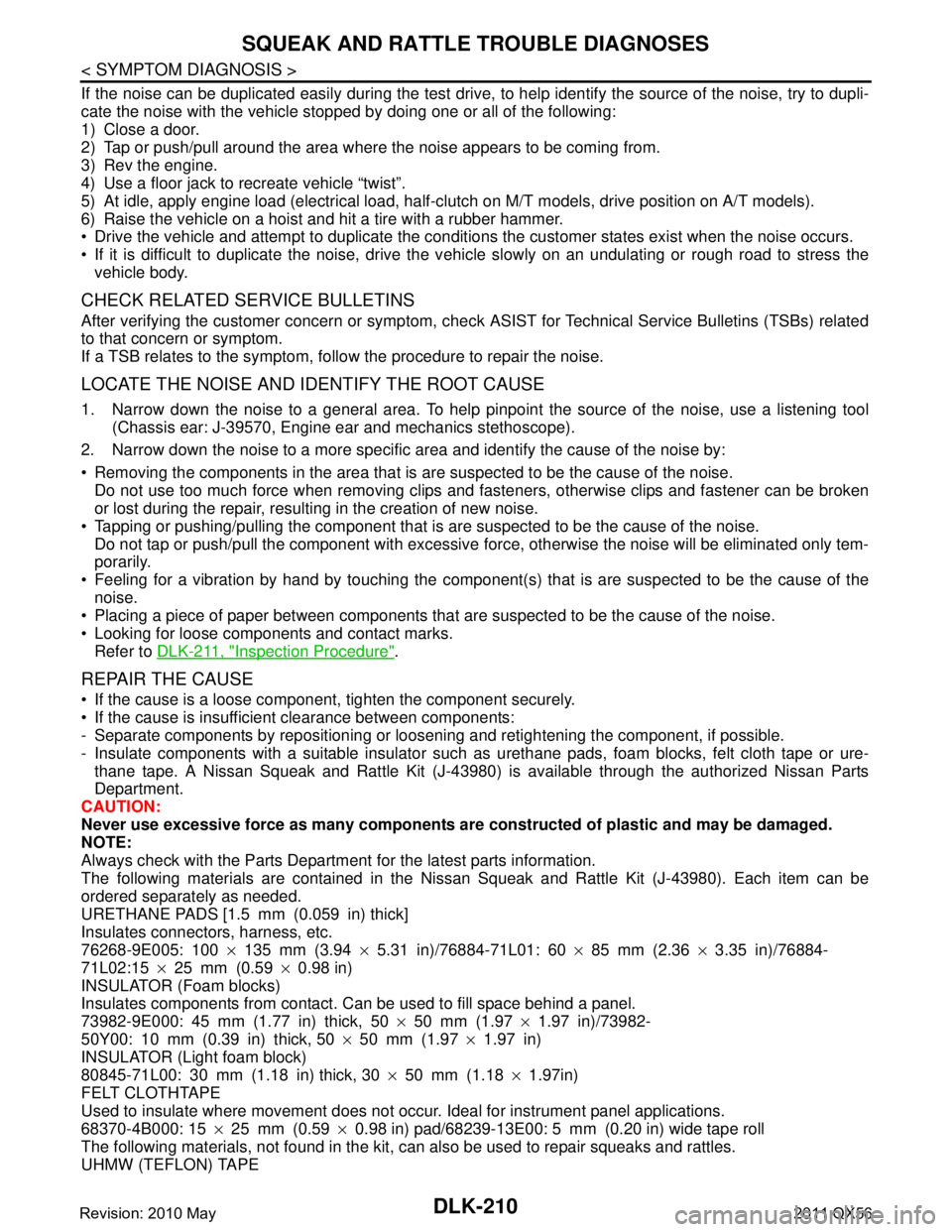
DLK-210
< SYMPTOM DIAGNOSIS >
SQUEAK AND RATTLE TROUBLE DIAGNOSES
If the noise can be duplicated easily during the test drive, to help identify the source of the noise, try to dupli-
cate the noise with the vehicle stopped by doing one or all of the following:
1) Close a door.
2) Tap or push/pull around the area where the noise appears to be coming from.
3) Rev the engine.
4) Use a floor jack to recreate vehicle “twist”.
5) At idle, apply engine load (electrical load, half-cl utch on M/T models, drive position on A/T models).
6) Raise the vehicle on a hoist and hit a tire with a rubber hammer.
Drive the vehicle and attempt to duplicate the conditions the customer states exist when the noise occurs.
If it is difficult to duplicate the noise, drive the v ehicle slowly on an undulating or rough road to stress the
vehicle body.
CHECK RELATED SERVICE BULLETINS
After verifying the customer concern or symptom, chec k ASIST for Technical Service Bulletins (TSBs) related
to that concern or symptom.
If a TSB relates to the symptom, follo w the procedure to repair the noise.
LOCATE THE NOISE AND IDENTIFY THE ROOT CAUSE
1. Narrow down the noise to a general area. To help pi npoint the source of the noise, use a listening tool
(Chassis ear: J-39570, Engine ear and mechanics stethoscope).
2. Narrow down the noise to a more specific area and identify the cause of the noise by:
Removing the components in the area that is are suspected to be the cause of the noise.
Do not use too much force when removing clips and fasteners, otherwise clips and fastener can be broken
or lost during the repair, resulting in the creation of new noise.
Tapping or pushing/pulling the component that is are suspected to be the cause of the noise.
Do not tap or push/pull the component with excessive force, otherwise the noise will be eliminated only tem-
porarily.
Feeling for a vibration by hand by touching the component (s) that is are suspected to be the cause of the
noise.
Placing a piece of paper between components that are suspected to be the cause of the noise.
Looking for loose components and contact marks. Refer to DLK-211, "
Inspection Procedure".
REPAIR THE CAUSE
If the cause is a loose component, tighten the component securely.
If the cause is insufficient clearance between components:
- Separate components by repositioning or loos ening and retightening the component, if possible.
- Insulate components with a suitable insulator such as urethane pads, foam blocks, felt cloth tape or ure-
thane tape. A Nissan Squeak and Rattle Kit (J-43980) is available through the authorized Nissan Parts
Department.
CAUTION:
Never use excessive force as many components are constructed of plastic and may be damaged.
NOTE:
Always check with the Parts Departm ent for the latest parts information.
The following materials are contained in the Nissan Squeak and Rattle Kit (J-43980). Each item can be
ordered separately as needed.
URETHANE PADS [1.5 mm (0.059 in) thick]
Insulates connectors, harness, etc.
76268-9E005: 100 ×135 mm (3.94 ×5.31 in)/76884-71L01: 60 ×85 mm (2.36 ×3.35 in)/76884-
71L02:15 ×25 mm (0.59 ×0.98 in)
INSULATOR (Foam blocks)
Insulates components from contact. Can be used to fill space behind a panel.
73982-9E000: 45 mm (1.77 in) thick, 50 ×50 mm (1.97 ×1.97 in)/73982-
50Y00: 10 mm (0.39 in) thick, 50 ×50 mm (1.97 ×1.97 in)
INSULATOR (Light foam block)
80845-71L00: 30 mm (1.18 in) thick, 30 ×50 mm (1.18 ×1.97in)
FELT CLOTHTAPE
Used to insulate where movement does not occu r. Ideal for instrument panel applications.
68370-4B000: 15 ×25 mm (0.59 ×0.98 in) pad/68239-13E00: 5 mm (0.20 in) wide tape roll
The following materials, not found in the kit, can also be used to repair squeaks and rattles.
UHMW (TEFLON) TAPE
Revision: 2010 May2011 QX56
Page 1748 of 5598

DLK-212
< SYMPTOM DIAGNOSIS >
SQUEAK AND RATTLE TROUBLE DIAGNOSES
Most of these incidents can be repaired by adjusting, securing or insulating the item(s) or component(s) caus-
ing the noise.
SUNROOF/HEADLINING
Noises in the sunroof/headlining area c an often be traced to one of the following:
1. Sunroof lid, rail, linkage or seals making a rattle or light knocking noise
2. Sunvisor shaft shaking in the holder
3. Front or rear windshield touching headlining and squeaking
Again, pressing on the components to stop the noise while duplicating the conditions can isolate most of these
incidents. Repairs usually consist of insulating with felt cloth tape.
SEATS
When isolating seat noise it is important to note t he position the seat is in and the load placed on the seat
when the noise is present. These conditions should be duplicated when verifying and isolating the cause of
the noise.
Cause of seat noise include:
1. Headrest rods and holder
2. A squeak between the seat pad cushion and frame
3. Rear seatback lock and bracket
These noises can be isolated by moving or pressing on the suspected components while duplicating the con-
ditions under which the noise occurs. Most of thes e incidents can be repaired by repositioning the component
or applying urethane tape to the contact area.
UNDERHOOD
Some interior noise may be caused by components under the hood or on the engine wall. The noise is then
transmitted into the passenger compartment.
Causes of transmitted underhood noise include:
1. Any component mounted to the engine wall
2. Components that pass through the engine wall
3. Engine wall mounts and connectors
4. Loose radiator mounting pins
5. Hood bumpers out of adjustment
6. Hood striker out of adjustment
These noises can be difficult to isolate since they cannot be reached from the interior of the vehicle. The best
method is to secure, move or insulate one component at a time and test drive the \
vehicle. Also, engine RPM
or load can be changed to isolate the noise. Repairs can usually be made by moving, adjusting, securing, or
insulating the component causing the noise.
Revision: 2010 May2011 QX56
Page 1788 of 5598
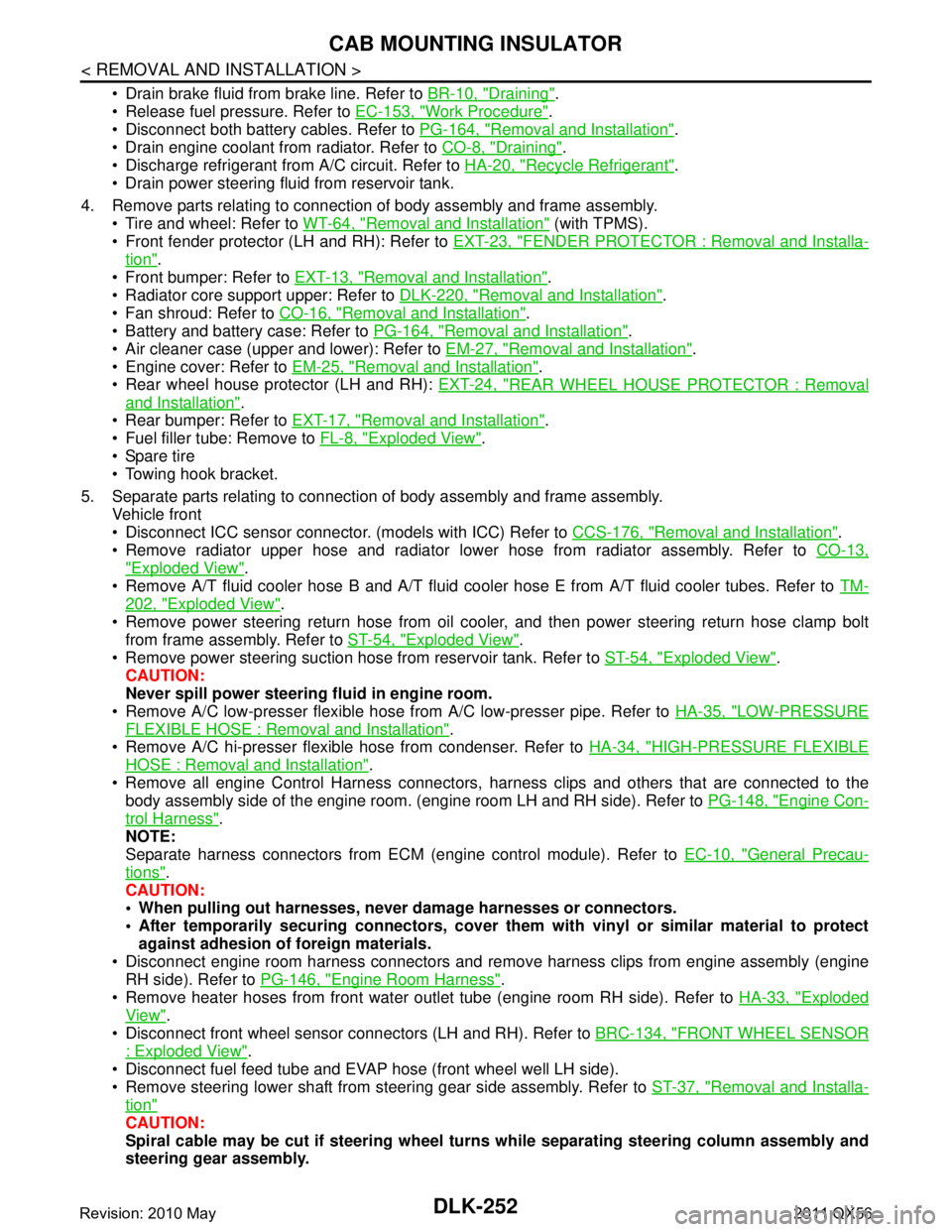
DLK-252
< REMOVAL AND INSTALLATION >
CAB MOUNTING INSULATOR
Drain brake fluid from brake line. Refer to BR-10, "Draining".
Release fuel pressure. Refer to EC-153, "
Work Procedure".
Disconnect both battery cables. Refer to PG-164, "
Removal and Installation".
Drain engine coolant from radiator. Refer to CO-8, "
Draining".
Discharge refrigerant from A/C circuit. Refer to HA-20, "
Recycle Refrigerant".
Drain power steering fluid from reservoir tank.
4. Remove parts relating to connection of body assembly and frame assembly. Tire and wheel: Refer to WT-64, "
Removal and Installation" (with TPMS).
Front fender protector (LH and RH): Refer to EXT-23, "
FENDER PROTECTOR : Removal and Installa-
tion".
Front bumper: Refer to EXT-13, "
Removal and Installation".
Radiator core support upper: Refer to DLK-220, "
Removal and Installation".
Fan shroud: Refer to CO-16, "
Removal and Installation".
Battery and battery case: Refer to PG-164, "
Removal and Installation".
Air cleaner case (upper and lower): Refer to EM-27, "
Removal and Installation".
Engine cover: Refer to EM-25, "
Removal and Installation".
Rear wheel house protector (LH and RH): EXT-24, "
REAR WHEEL HOUSE PROTECTOR : Removal
and Installation".
Rear bumper: Refer to EXT-17, "
Removal and Installation".
Fuel filler tube: Remove to FL-8, "
Exploded View".
Spare tire
Towing hook bracket.
5. Separate parts relating to connection of body assembly and frame assembly. Vehicle front
Disconnect ICC sensor connector. (models with ICC) Refer to CCS-176, "
Removal and Installation".
Remove radiator upper hose and radiator lower hose from radiator assembly. Refer to CO-13,
"Exploded View".
Remove A/T fluid cooler hose B and A/T fluid cooler hose E from A/T fluid cooler tubes. Refer to TM-
202, "Exploded View".
Remove power steering return hose from oil cooler, and then power steering return hose clamp bolt from frame assembly. Refer to ST-54, "
Exploded View".
Remove power steering suction hose from reservoir tank. Refer to ST-54, "
Exploded View".
CAUTION:
Never spill power steering fluid in engine room.
Remove A/C low-presser flexible hose from A/C low-presser pipe. Refer to HA-35, "
LOW-PRESSURE
FLEXIBLE HOSE : Removal and Installation".
Remove A/C hi-presser flexible hose from condenser. Refer to HA-34, "
HIGH-PRESSURE FLEXIBLE
HOSE : Removal and Installation".
Remove all engine Control Harness connectors, har ness clips and others that are connected to the
body assembly side of the engine room. (engine room LH and RH side). Refer to PG-148, "
Engine Con-
trol Harness".
NOTE:
Separate harness connectors from ECM (engine control module). Refer to EC-10, "
General Precau-
tions".
CAUTION:
When pulling out harnesses, never damage harnesses or connectors.
After temporarily securing connectors, cover th em with vinyl or similar material to protect
against adhesion of foreign materials.
Disconnect engine room harness connectors and remo ve harness clips from engine assembly (engine
RH side). Refer to PG-146, "
Engine Room Harness".
Remove heater hoses from front water outlet tube (engine room RH side). Refer to HA-33, "
Exploded
View".
Disconnect front wheel sensor connectors (LH and RH). Refer to BRC-134, "
FRONT WHEEL SENSOR
: Exploded View".
Disconnect fuel feed tube and EVAP hos e (front wheel well LH side).
Remove steering lower shaft from steering gear side assembly. Refer to ST-37, "
Removal and Installa-
tion"
CAUTION:
Spiral cable may be cut if steering wheel turns while separating steering column assembly and
steering gear assembly.
Revision: 2010 May2011 QX56